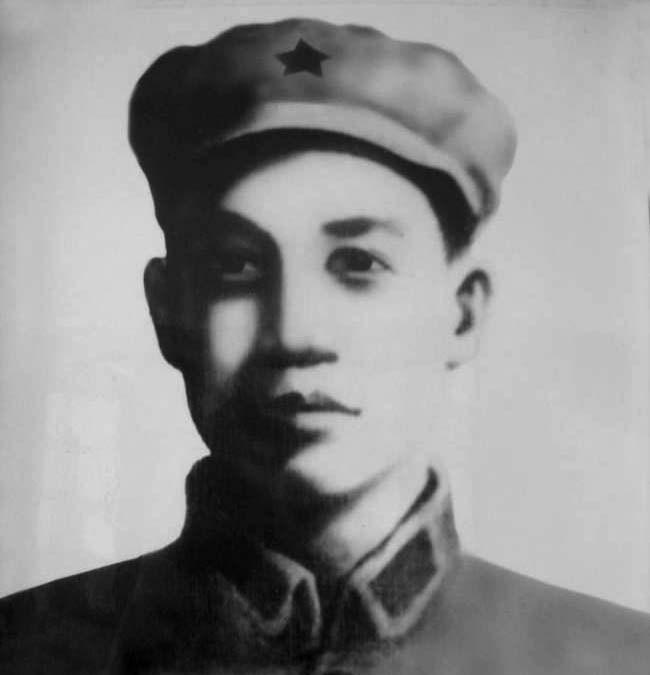On October 20, 1934, the Red 4th Division, as the vanguard of the Long March of the Red Army, took the lead in advancing through Tangkengkou in Ganxian County and To Xintian Baishi Village in Xinfeng County according to the orders of the Central Revolutionary Military Commission and the Red Third Army, preparing to break through the first blockade line of the Kuomintang army.
The commander of the Red 4th Division was named Hong Chao, who had been a guard for Zhu Laozong at the age of 25.

Hong Chao was a native of Huangmei, Hubei Province, and when he was 18 years old, he joined the teaching team of the 24th Division of the National Revolutionary Army, where Ye Ting was the commander of the division, as a cadet, and then participated in the Guangzhou Uprising, and then went to the vicinity of Shaoguan to transfer to the Nanchang Uprising troops led by Zhu Laozong and Chen Laozong.
Later, under the guidance of Chairman, President Zhu, Mr. Peng, and Mr. Chen, Hong Chao grew up rapidly, and was successively promoted from platoon commander to staff officer, regimental commander, and division commander of the Red 5 Army. Hong Chao was seriously wounded and lost his left arm during the fourth anti-"encirclement and suppression" battle. However, he was disabled, and two months later, he was appointed commander of the Fourth Division of the Red Third Army, and continued to lead his troops to participate in the fifth anti-"encirclement and suppression" battle.
The first blockade line of the Kuomintang was defended by the Cantonese army commanded by chen Jitang, the commander-in-chief of the Cantonese army. At that time, the Guangdong Army and our Red Army reached an agreement through negotiations, and the Red Army borrowed the "five agreements" from Chen's defense zone. According to this agreement, the Red Army should be able to safely pass through the Cantonese army's defensive zone when it advances westward.
However, in order to hide the eyes and ears of old Chiang Kai-shek, the two sides did not clearly convey the contents of the agreement downwards, and the Cantonese army only vaguely ordered officers above the rank of major general, "The enemy does not attack me, and is not allowed to attack; the enemy does not shoot at me, and is not allowed to shoot!" "As for the Red Army, in order to strictly guard the secrets of the breakthrough, it did not convey the contents of the secret agreement to the subordinates, and did not inform the Guangdong army of the road to be passed (worried that the Cantonese army was different, ambushed on the way), so it adopted the method of forcibly borrowing the road.
Therefore, when the Red Fourth Division arrived at Baishi Village on October 21, it was caught on fire with the Cantonese defenders. Thus, the first battle of the Long March, the Battle of Baishi, was launched.
Under the command of division commander Hong Chao and political commissar Huang Kecheng, the Red Fourth Division seized the commanding heights near Baishi with lightning speed, set up machine guns, and fired fiercely at the defending enemy. The Red Army wanted them to surrender, but the Cantonese troops inside kept firing guns at the outside, even killing the Red Army soldiers who were shouting.
At this time, the division commander Hong Chao also happened to pass by here, and after he went to the front to observe the situation, he ordered the mobilization of mortars to eliminate the enemy inside the wall. However, as soon as the words fell, Commander Hong Chao was shot in the head by a criminal bullet from the enemy inside the wall and died on the spot.
Hong Chao's sacrifice made his comrades-in-arms deplore. The soldiers angrily shouted the slogan of "avenging the division commander", rushed inside, completely annihilated the stubborn enemy, and the enemy squadron commander He Depan was executed after being paraded in the street.
Hong Chao's unfortunate sacrifice made him the first Red Army division commander to die in the Long March, and his old superior, Mr. Peng, said after learning of Hong Chao's sacrifice, "Comrade Hong Chao's revolutionary spirit of being a pioneer and heroically killing the enemy is worth learning from my generation!" ”
More Exciting Articles:
After the July 7 Incident, thousands of Red Army troops in southern Fujian were deceived into surrendering their weapons, and he led the backbone to successfully break through, and was later appointed lieutenant general
This person is a famous general of Liang, what virtue and how can he? Even the great men called for: Learn from him!